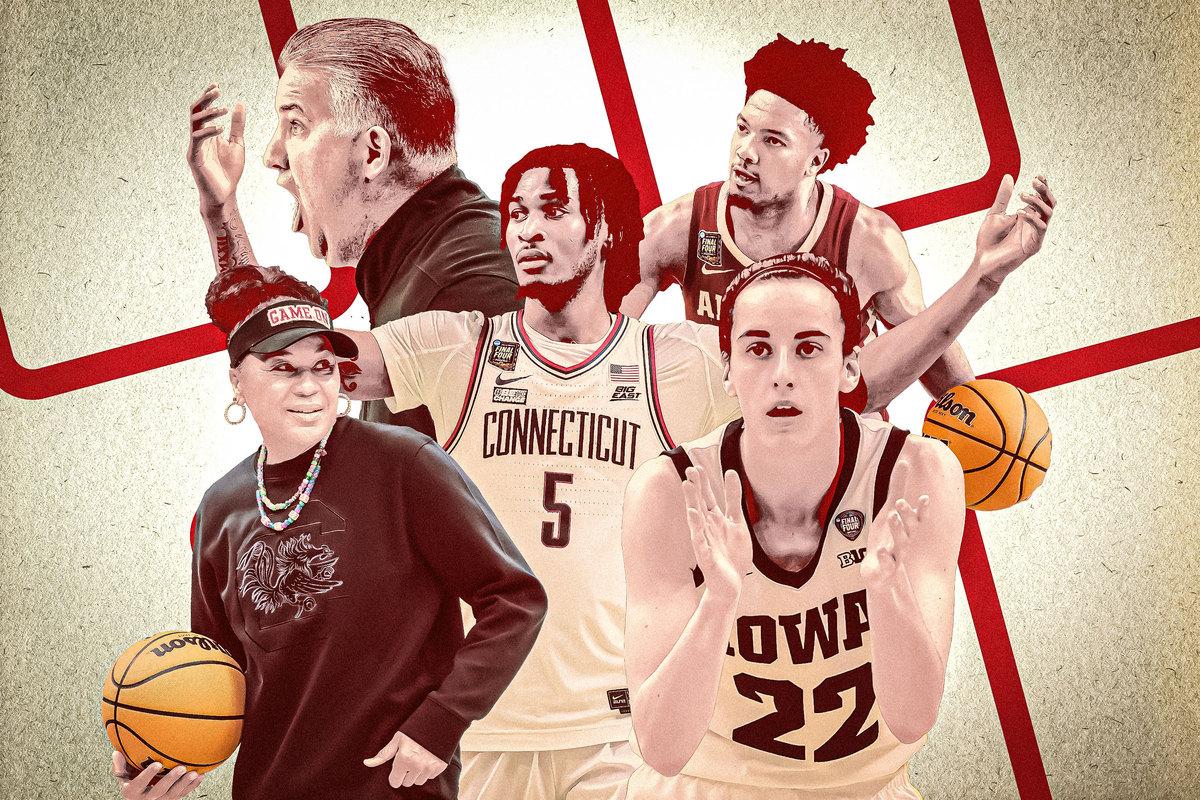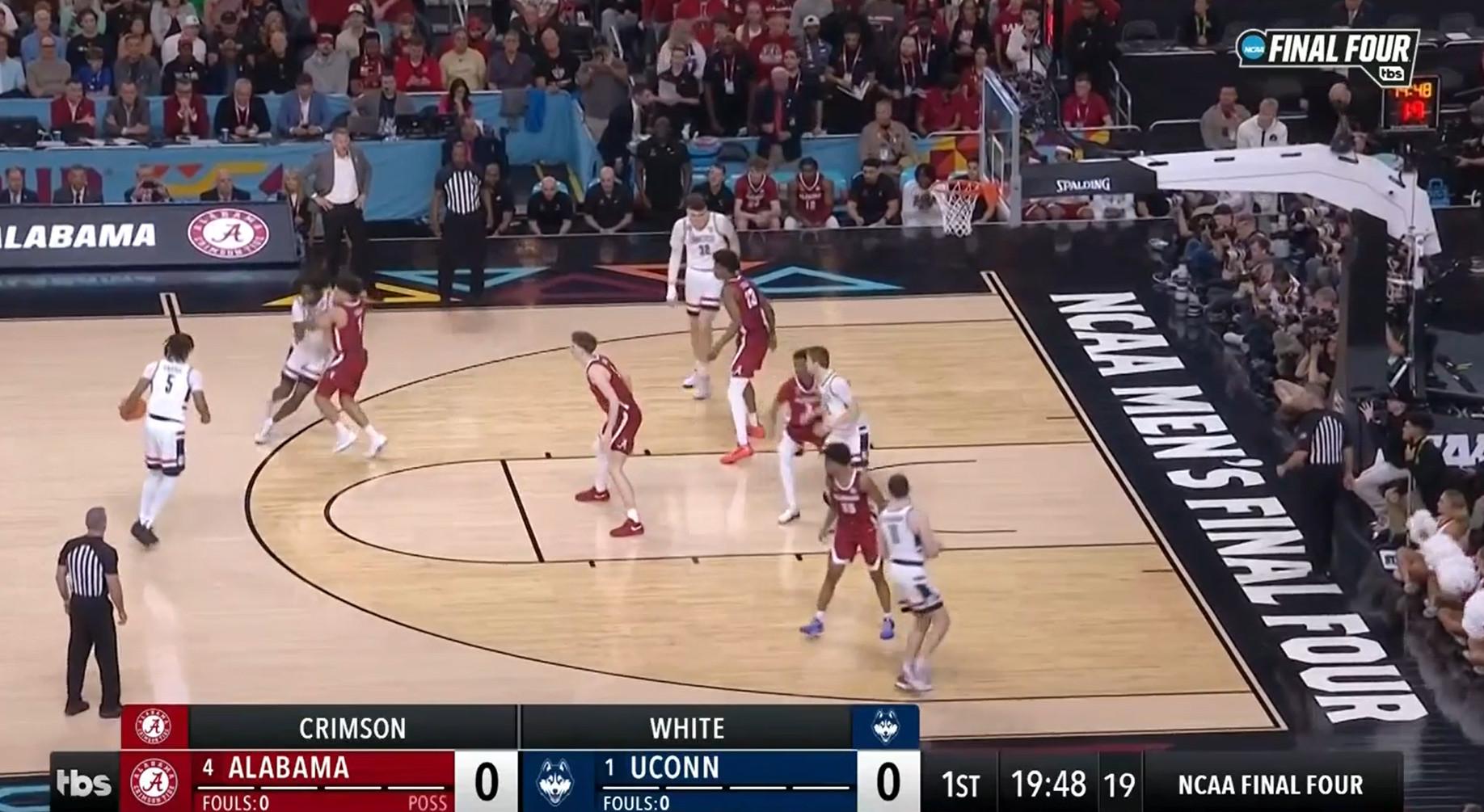Winners and Losers of the Final Four
From Dawn Staley’s best coaching job to Matt Painter’s redemption plan to Stephon Castle’s big night for UConn to wild TV ratings for the women’s semifinals, here are the winners and losers of the Final Four
The championship matchups are set. Who shined brightest in the Final Four? Who fell short? Let’s dive into a special edition of Winners and Losers.
Winners: Fans of Blockbusters
You know, March doesn’t always have to be so damn mad to be entertaining. A more chalky tournament can provide its fair share of thrills, and as we’ve seen on both the men’s and women’s sides, the quality of games is a hell of a lot better when the best teams make deep runs. Because single-elimination tournaments tend to produce chaotic results, we rarely see the two actual best teams play in the national title game. But we’re getting the rare twofer this year as Iowa and South Carolina face off for the women’s championship on Sunday and Connecticut plays Purdue for the men’s title on Monday.
The two matchups fall in the same narrative bucket: On one side, you have a Big Ten team that revolves around its star player who was recently crowned the Player of the Year; on the other, you have a team with a championship history that has dominated opponents with a remarkably balanced attack and a deep bench. Even the opening betting lines for each game are identical, with UConn and South Carolina starting as 6.5-point favorites.
There is obviously a massive difference in how Iowa’s Caitlin Clark and Purdue’s Zach Edey play, but they have a similar effect on how opponents set up defensively. In Iowa’s win over Connecticut in the women’s Final Four, the Huskies had a defender face guard Clark for 94 feet, forcing her to earn every shot—even the ones from the logo. The plan worked … initially. Clark missed her first six attempts from 3-point range and turned it over five times in the first half, but her gravity opened up the court for her teammates. And when Clark eventually settled into the game, Iowa grabbed the lead and didn’t give it up, winning 71-69. That’s similar to how things went for Edey on Saturday. NC State had enough size to bother Edey, who turned it over five times, but the attention on the 7-foot-4 center left Purdue’s shooters wide open on the perimeter. The 3s helped the Boilermakers build enough of a lead while Edey figured things out. When he got rolling in the second half, Purdue pulled away and won 63-50. Edey and Clark both showed that their off nights were still enough to power their respective teams.
UConn and South Carolina both have plenty of star power, but they aren’t reliant on any one player to put the ball in the basket. The Huskies have five players averaging at least 10 points per game. The Gamecocks have seven players averaging at least eight. Dealing with all those options can be overwhelming for opponents. This isn’t an official stat, but both teams must lead the nation in demoralizing scoring runs. UConn closed the door on Alabama in the Final Four with a quick 7-0 run inside the game’s final three minutes before winning 86-72—a week after dropping a historic 30-0 run on Illinois. South Carolina wrapped up its spot in the title game by outscoring NC State by 23 points in the third quarter, winning the game 78-59 after leading by just one at halftime. These teams don’t just beat their opponents. They break them.
As Connecticut coach Dan Hurley said after UConn’s win on Saturday, the Huskies and Boilermakers have been the two best teams in men’s college basketball for the past two years. I’d say the same about South Carolina and Iowa on the women’s side. The best part is that we don’t need to waste time debating which team is the best on either side. We get to watch them settle it on the court over the next two days.
Losers: Nate Oats and the Stephon Castle Doubters
Alabama head coach Nate Oats believed in the numbers heading into the Final Four: UConn’s Stephon Castle shoots 26.3 percent on jump shots this season. He shoots just 26.8 percent from 3, and his percentage (23.1) is even worse on unguarded shots from distance. Connecticut’s freshman guard might do things at a high level, but shooting a basketball is not one of them. So Oats put 6-foot-11 Grant Nelson on Castle and had him sag off the poor shooter. Nelson could just hang out in the middle of the paint and disrupt UConn’s offensive flow.

This tactic is known as “dorking” in basketball terminology. And, yes, that’s precisely what it means. Oats essentially called Castle a dork and dared him to shoot it from deep. After bricking his first attempt on an open 3, Castle drilled the second. And then hit another wide-open 3 later in the first half. After the game, he said Alabama’s “disrespectful” plan got him going early in Connecticut’s win.
Castle finished with a game-high 21 points on 7-of-13 shooting. Those two early 3s burned Bama, but Castle missed his four other attempts from deep, so Oats’s plan kind of worked in that regard. The problem is, Hurley had plenty of counters designed to exploit the Tide’s defensive setup. Jay Wright did a fantastic job of explaining how Hurley did it in various ways on the TNT postgame show.
Hurley has seen these tactics before. Last season, Xavier had success leaving former UConn forward Andre Jackson Jr. wide open in an early conference game the Huskies would lose. Opponents copied that plan, and Connecticut stumbled through the early part of Big East play, losing six of eight. But Hurley eventually figured out the proper counters, and Jackson became one of the main contributors to their championship run. Gonzaga decided to give that defensive plan a go in last year’s Elite Eight and got picked apart by Jackson, who acted as a roaming playmaker in a dominant 82-54 win.
“We figured that out,” Hurley told The Athletic’s C.J. Moore after that win last March. “That doesn’t work anymore. To be honest with you, [it was] coaching mistakes during the season where it just took me too long to get Andre to the places where he could still be one of the biggest impact players in terms of winning and losing. There’s not many players in the country that impact the game the way this guy does.”
The same is true of Castle now. He’s not the playmaker Jackson was, but he’s a much better scorer and might be the best perimeter defender in college basketball. And while he doesn’t create a lot of shots for others, he is a willing passer. He crashes the boards hard, gets back on defense, and is one of the team’s toughest players as just a freshman. So, I don’t actually think Oats’s game plan was inspired by a lack of respect for Castle’s game. It was desperation. He had to give up something to have a chance at defending Connecticut’s multilayered half-court offense. Based on the numbers, sagging off of Castle seemed the best course of action. It just didn’t work.
Winner: Dawn Staley’s Quick Rebuild
In hindsight, South Carolina’s preseason ranking may have been too low. The Gamecocks, the only undefeated team remaining on either the women’s or men’s side, opened the season ranked sixth in the polls but quickly climbed to the top after early blowout wins over Notre Dame and Maryland. The voters didn’t need much convincing.
It’s hard to blame them for their initial skepticism. Even the players themselves weren’t confident after South Carolina lost its entire starting lineup from the previous season, including national Player of the Year Aliyah Boston. “You can ask any of my teammates: We thought we weren’t gonna be good,” Bree Hall told ESPN. “The Notre Dame game was a shocker. It was like, ‘Oh, oh, we’re actually pretty good, guys. We’re good.’”
For a team that lost so much, it’s remarkable how deep into its bench South Carolina can go. Staley plays a rotation of nine players. Kamilla Cardoso is the star of the show but averages a modest 14.3 points per game. Freshman guard MiLaysia Fulwiley isn’t too far behind at 11.8 points per contest. And Oregon transfer Te-Hina Paopao is third in scoring at 10.9 points per game. Ashlyn Watkins, Chloe Kitts, and Hall average between 9.0 and 9.4 points per game. Raven Johnson, a bench player last season, averages only 8.2 points per game but leads the team in assists and steals while grabbing over five boards per game.
South Carolina’s depth wore on the Wolfpack in South Carolina’s semifinal win. Four players logged over 30 minutes for NC State in that game. The Gamecocks didn’t have a single player do that, but eight players went for at least 16 minutes. The difference in energy between the two teams coming out of the halftime break was stark. The Wolfpack shot 1-of-11 in the period and managed just six points. As NC State was starting to fade, South Carolina was getting stronger. That’s how the Gamecocks have rolled all season.
Staley is now a win away from her third national title, and this might be her most impressive coaching job yet. The roster turned out to be more talented than anyone could have imagined, but that wouldn’t have happened without Staley’s impeccable eye for talent. This team wouldn’t share the ball as well as it does without complete buy-in from the locker room. It wouldn’t be undefeated without Staley’s ability to pull all the right strings in crunch time. There isn’t another coach in the country who could have pulled this off.
Loser: Whoever Scheduled the Women’s Final
With 14.2 million viewers tuning in on Friday night, Iowa-UConn was the most-watched basketball game in the history of ESPN, a network that has broadcast an unfathomable number of basketball games over its 45-year existence. It’s another win for the sport and more proof that massive audiences will tune in for women’s college basketball if the networks put it on television—even if tipoff is at 9:30 ET. Clark’s stardom has been the catalyst for this year’s overall spike in viewership, but the ratings have been trending in this direction for years now. It’s not exactly a surprise that so many people are tuning in for these games, which makes the 3 p.m. ET start time for Sunday’s national title game a little confusing. How is this game not being played in prime time? It’s not too late to fix this.
Clark and Iowa are the biggest draws in sports right now, so expect another massive television audience for the title game. But you have to think the NCAA and ESPN are leaving plenty of meat on the bone by playing this game during prime errand-running hours. If you’re a hoops fan on the West Coast who had a long Saturday night, you might have to set an alarm just to get up in time for the game. Championship games should not be played before dinnertime.
In a comment to Front Office Sports, an ESPN spokesperson said that women’s college basketball games “have seen success both in the afternoon and evening,” which is more of a statement of fact than an explanation for the early start time. The game is simultaneously televised on ABC, which airs American Idol on Sunday nights, which means Katy Perry and Lionel Richie may be responsible for the inconvenient start time. You know where to send your complaints.
Winner: Matt Painter
Turning the page would have been easy after suffering the most embarrassing defeat in Purdue basketball history. Writing off the shocking first-round loss to 16th-seeded Fairleigh Dickinson in last year’s tournament as little more than a fluke would have been understandable, too. But Matt Painter didn’t do that after the top-seeded Boilermakers became the second team to lose in a 16-over-1 upset. He took the opposite approach, using that loss to shape this year’s squad that will play for a national title on Monday night.
Two major issues led to that historic upset: Purdue struggled from 3-point range, so Fairleigh Dickinson could throw double- and triple-teams at Edey without consequence, and the Boilermakers couldn’t cope with FDU’s quickness on either end of the court. Painter spent the offseason addressing both issues. First, he scoured the transfer portal for a wing player who could shoot the 3 and take on Big Ten guards on the defensive end. He found Lance Jones, who hadn’t shot the ball well during the 2022-23 season but had shown promise as a shooter during his first two seasons at Southern Illinois. Then Painter loaded up Purdue’s non-conference slate with teams similar to Fairleigh Dickinson. That included early-season games against Morehead State and Samford, two popular Cinderella picks when the brackets came out last month. Purdue also played Marquette, Gonzaga, Xavier, Tennessee, Alabama, and Arizona—power-conference schools that like to push the pace and would put pressure on the Boilermakers’ ball handlers. Painter wouldn’t let this team go out sad like last year’s bunch did.
Purdue ran the table against that gauntlet of pressure teams, showing that last season’s blueprint was no longer viable against this season’s team. And thanks to the addition of Jones, who shoots 36 percent from 3, and the improvement of returning players Braden Smith, Fletcher Loyer, and Mason Gillis, Purdue went from one of the nation’s worst 3-point shooting teams to one of its best. On Sunday, that 3-point shooting made up for an up-and-down day for Edey. The big center was, unsurprisingly, the focal point of NC State’s defensive plan. Whenever he put the ball on the deck, a second defender would dig at the ball, which freed up shooters elsewhere. Jones hit four of his nine 3-point attempts. Loyer drilled three shots from deep, and Gillis came off the bench to hit two 3s. The Boilermakers finished 10-of-25 from beyond the arc in the win over the Wolfpack. In last year’s loss to FDU, they made only five out of 26 such shots. Frankly, it was the type of game that Purdue probably would have lost last season. Edey was somewhat neutralized—a 20-point outing is pedestrian based on his lofty standards—and the game hinged on the performance of his supporting cast. Thanks to Painter’s work this offseason, the Boilermakers can win those games comfortably now.
Losers: NC State and Storybook Endings
There are many ways to win a basketball game. Unfortunately for NC State, all of them require putting the ball in the basket at some point. That’s about the only thing the Wolfpack didn’t do against Purdue in a loss that ended their postseason win streak at nine games dating back to the ACC tournament. The Boilermakers shot just 40 percent from the field. They turned it over 16 times and had a season-high turnover rate of 24.9 percent. It was Purdue’s second-worst performance of the season based on offensive efficiency, per KenPom. Edey finished with his worst offensive rating (1.19 points per possession) in a game since February 15. This was the game NC State had to play on the defensive end to beat the Big Ten regular-season champs. They just couldn’t put the ball in the basket.
State’s offense never got in a rhythm. Even when it could string a few baskets together, they were the result of difficult shotmaking or sloppy play by Purdue. Nothing came easy in its half-court offense. The tournament’s breakout star, DJ Burns Jr., made a few shots over Edey but could never take over the game. DJ Horne may have been the best player on the floor but ran out of gas after carrying the Wolfpack’s offense through the first 20 minutes. Casey Morsell, who hadn’t been held under double digits all season, finished scoreless on 0-of-5 shooting. Purdue’s defense played a role in the off night for the Wolfpack, but they also missed a number of open shots that could have shifted the momentum of the game.
NC State coach Kevin Keatts, whose seat had been awfully hot before a run to the Sweet 16 triggered an automatic contract extension with the school, put together a masterful game plan. The Wolfpack handled Edey as well as any team in this tournament. Their ball pressure bothered Purdue’s backcourt and delayed the timing of the half-court offense. They got plenty of open looks on the offensive end. This had all the ingredients of an upset except for the most important one.
Winner: The Transfer Portal
It’s been a few years since the transfer portal began operating, and college sports have yet to be destroyed as some predicted they would. It turns out that letting players change schools has little to no impact on the actual basketball games. If anything, it has improved the quality of play we’ve seen in both the men’s and women’s tournaments. The two most dominant teams we’ve seen this spring—South Carolina’s women and UConn’s men—were built through the portal. Cardoso could still be stuck at Syracuse instead of leading SC’s undefeated season if not for the relaxed transfer policy. Cam Spencer and Tristen Newton, who make up the nation’s best backcourt on the men’s side, might be stuck in a midtier conference instead of leading UConn back to the national title game. Alabama, who flamed out in last year’s tournament but has played in some of the most entertaining games we’ve seen over the last month, was built around a core of transfers in Mark Sears, Aaron Estrada, and Grant Nelson. NC State’s Burns, one of the tournament’s enduring stars, played at Winthrop two years ago and may have graduated in relative anonymity if he wasn’t given a chance to transfer a second time after an early stint at Tennessee didn’t work out for the big man.
It’s not just the star players benefiting from the portal, either. Championship-caliber teams can now seek out players with specific skill sets to fill in gaps in their rosters, which has raised the quality of role players we’re seeing on power-conference teams. Purdue brought in Jones as a 3-and-D guy who could supplement what Edey and Smith do best. Spencer isn’t Connecticut’s best player, but he might be its most important piece. South Carolina’s perimeter shooting, or lack thereof, cost Staley a perfect season a year ago, so she brought in Paopao via the portal and solved that problem.
There was a fear that the portal and NIL rules would create a free agent market for college athletes. And it sort of has, but the drawbacks of such a system haven’t become apparent just yet. Players are, for the most part, making money and landing in better situations. Coaches can fill out their rotations with more experienced players. And the product is more entertaining for fans at home because the name-brand programs aren’t filling their rosters with 18-year-olds who don’t know how to play basketball yet. In the era of the transfer portal, everybody wins. Well, except John Calipari.

